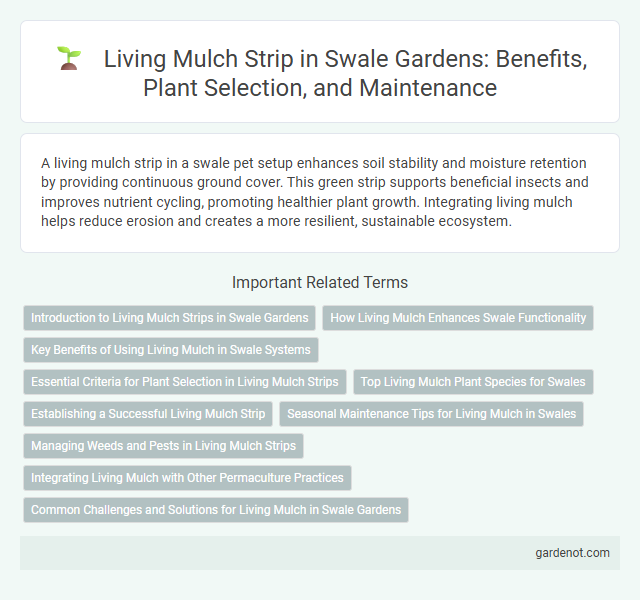A living mulch strip in a swale pet setup enhances soil stability and moisture retention by providing continuous ground cover. This green strip supports beneficial insects and improves nutrient cycling, promoting healthier plant growth. Integrating living mulch helps reduce erosion and creates a more resilient, sustainable ecosystem.
Introduction to Living Mulch Strips in Swale Gardens
Living mulch strips in swale gardens enhance soil health by reducing erosion and improving water infiltration. These strips typically consist of ground-cover plants that suppress weeds and retain moisture, fostering a sustainable growing environment. Integrating living mulch within swales optimizes stormwater management by promoting natural filtration and nutrient cycling.
How Living Mulch Enhances Swale Functionality
Living mulch in swales improves soil structure by increasing organic matter and promoting microbial activity, which enhances water infiltration and retention. The root systems of living mulch stabilize soil, reducing erosion and nutrient runoff during heavy rainfall events. Furthermore, living mulch supports biodiversity by providing habitat for beneficial insects that contribute to pest control and overall ecosystem health within the swale.
Key Benefits of Using Living Mulch in Swale Systems
Living mulch in swale systems enhances soil moisture retention by reducing evaporation and promoting infiltration. It suppresses weed growth, minimizing competition for nutrients and improving overall plant health. This practice also boosts biodiversity and supports beneficial soil microorganisms, contributing to long-term soil fertility and ecosystem stability.
Essential Criteria for Plant Selection in Living Mulch Strips
Living mulch strips in swales require plants with deep root systems to enhance soil stabilization and water absorption. Selection criteria include drought tolerance, low maintenance demands, and the ability to suppress weeds naturally. Choosing native species adapted to local climate conditions ensures biodiversity support and long-term ecological resilience.
Top Living Mulch Plant Species for Swales
Top living mulch plant species for swales include native grasses like buffalo grass (Bouteloua dactyloides), creeping thyme (Thymus serpyllum), and clover varieties such as white clover (Trifolium repens). These plants provide excellent soil stabilization, moisture retention, and weed suppression within swale environments. Selecting species with deep root systems and drought tolerance enhances swale performance in managing stormwater runoff and promoting healthy soil structure.
Establishing a Successful Living Mulch Strip
Establishing a successful living mulch strip in a swale requires selecting hardy, low-maintenance ground cover species such as clover, creeping thyme, or native grasses to enhance soil stability and water retention. Proper site preparation including soil amendment and moisture management promotes rapid establishment and reduces weed competition. Regular monitoring and adaptive management ensure the living mulch strip supports biodiversity, controls erosion, and improves swale functionality over time.
Seasonal Maintenance Tips for Living Mulch in Swales
Seasonal maintenance of living mulch in swales involves regular inspection to ensure healthy ground cover and effective erosion control. During spring and summer, trimming excessive growth promotes air circulation and prevents shading of swale vegetation. In fall, remove fallen leaves and debris to maintain soil moisture and prevent compaction, enhancing the swale's water absorption capacity.
Managing Weeds and Pests in Living Mulch Strips
Living mulch strips in swales effectively suppress weeds by providing continuous ground cover that limits sunlight and space for weed growth. These strips also harbor beneficial insects that naturally control pest populations, reducing the need for chemical interventions. Proper selection of cover plants and timely maintenance enhances the resilience and ecological function of living mulch strips in integrated pest management.
Integrating Living Mulch with Other Permaculture Practices
Integrating living mulch strips within swale systems enhances soil moisture retention and erosion control by leveraging ground cover plants like clover or legumes. These living mulches promote biodiversity, enrich soil nitrogen through natural fixation, and support beneficial insect habitats, aligning with permaculture principles. Combining swales and living mulches optimizes water management, soil fertility, and ecosystem resilience in sustainable land management.
Common Challenges and Solutions for Living Mulch in Swale Gardens
Living mulch strips in swale gardens often face challenges like competition for water and nutrients, pest infestations, and maintenance complexity. Selecting drought-tolerant, native plant species minimizes resource competition, while integrated pest management techniques reduce pest pressures effectively. Regular pruning and monitoring ensure healthy mulch growth, enhancing soil moisture retention and erosion control in swale systems.
Living mulch strip Infographic

 gardenot.com
gardenot.com